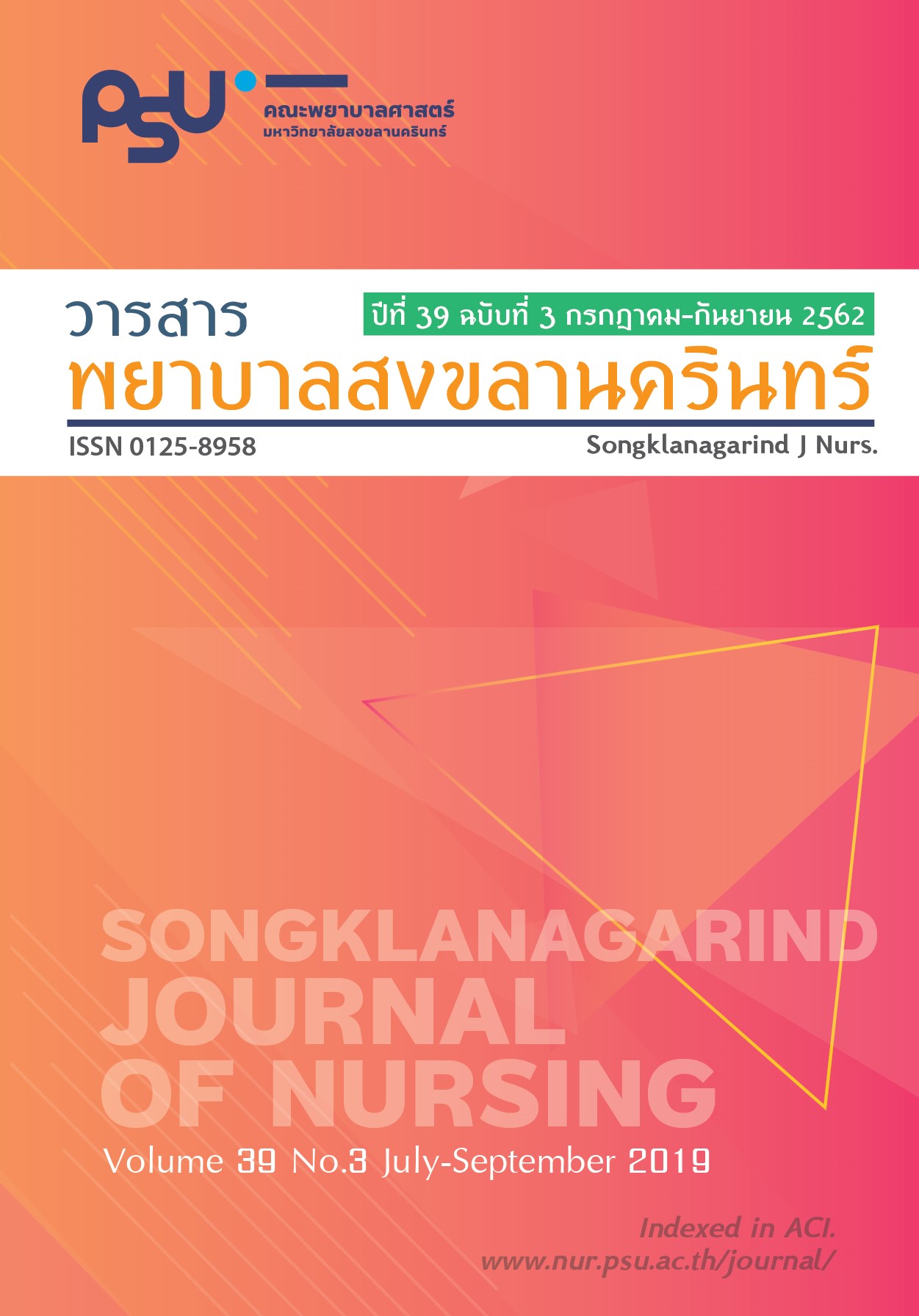Foot Health Assessment Among People with Diabetes for Healthcare Professionals
Main Article Content
Abstract
The prevalence of diabetic foot ulcers increases significantly every year among people especially who cannot control their blood glucose levels. High blood glucose levels can cause diabetic neuropathy and sweat gland dysfunction which can develop foot ulcers. Amputation may be considered where the combination of bacterial infection and long-term unhealed foot ulcers are becoming to gangrenous. Foot health assessment among people with diabetes is important for healthcare professionals and can prevent the development of unhealed diabetic foot ulcers. In addition, it can reduce the amputation rate among people with diabetes. The purpose of this article was to provide a foot examination process including the details of using Semmes-Weinstein monofilament (10g), Tuning fork, and the Ankle Brachial Index (ABI) measurement, classification risk of diabetic foot ulcers, and practice guidelines for preventing diabetic foot ulcers regarded as high risk. All the knowledge and clinical assessments can assist the health care providers in the assessment of people with diabetic foot ulcers and prevent severe diabetic foot ulcers in areas lacking a specialist or primary care provider able to make a referral to a specialist.
Article Details
References
Meetoo D. Diabetes: Complications and the economic burden. BRIT J HEALTHC MANGE. 2014; 20(2): 60-7.
IDF. The Diabetic Foot 2019 [cited 2019 16-04]. Available from: https://www.idf.org/our-activities/care-prevention/diabetic-foot.html.
Walsh J, Hoffstad O, Sullivan M, Margolis D. Association of diabetic foot ulcer and death in a population‐based cohort from the United Kingdom. Diabetic Medicine. 2016; 33(11): 1493-8.
Khunkaew S, Fernandez R, Sim J. Health-related quality of life and self-care management among people with diabetic foot ulcers in northern Thailand. SAGE Open Nursing. 2019;5:2377960819825751.
Khunkaew S, Tungpunkom P, Sim J, Fernandez RS. The Experiences of people in Northern Thailand living with Diabetic Foot Ulcers: A descriptive qualitative study. Pac Rim Int J Nurs Res. 2018; 22(4): 304-18.
Gershater MA, Pilhammar E, Apelqvist J, Alm‐Roijer C. Patient education for the prevention of diabetic foot ulcers: Interim analysis of a randomised controlled trial due to morbidity and mortality of participants. Eur Diabetes Nurs. 2011;8(3):102-7b.
Sadosky A, Schaefer C, Mann R, Bergstrom F, Baik R, Parsons B, et al. Burden of illness associated with painful diabetic peripheral neuropathy among adults seeking treatment in the US: results from a retrospective chart review and cross-sectional survey. Diabetes Metab Syndr Obes. 2013; 6:79.
Dubský M, Jirkovská A, Bem R, Fejfarová V, Skibová J, Schaper NC, et al. Risk factors for recurrence of diabetic foot ulcers: prospective follow‐up analysis in the Eurodiale subgroup. Int Wound J. 2013; 10(5): 555-61.
ADA. Microvascular complications and foot care: Standards of Medical Care in Diabetes—2019. Diabetes care. 2019; 42(Supplement 1): S124-S38.
DMTHAI. Clinical Practice Guideline for Diabetes 2017. Pathum Thani: Diabetes Association of Thailand under The Patronage of Her Royal Highness Princess Maha Chakri Sirindhorn; 2017. Thai.
Thewjitcharoen Y, Krittiyawong S, Porramatikul S, Parksook W, Chatapat L, Watchareejirachot O, et al. Outcomes of hospitalized diabetic foot patients in a multi-disciplinary team setting: Thailand's experience. J Clin Transl Endocrinol. 2014; 1(4): 187-91.
Numpoon J. The Nurse's Role in Preventing Diabetic Foot Ulcers. The Thai Red Cross College of Nursing. 2011; 4(1-3): 1-3 Thai.
Tan LS. The clinical use of the 10 g monofilament and its limitations: A review. Diabetes Res Clin PR. 2010; 90(1): 1-7.
Bakker K. Practical guidelines on the management and prevention of the diabetic foot 2011 Management and Prevention of the Diabetic Foot. Diabetes Metab Res. 2012; 28: 225-31.
Feng Y. The Semmes Weinstein monofilament examination as a screening tool for diabetic peripheral neuropathy. J Vasc Surg. 2009; 50(3): 675-82.
Schaper N, Van Netten J, Apelqvist J, Lipsky B, Bakker K, International Working Group on the Diabetic Foot (IWGDF). Prevention and management of foot problems in diabetes: A summary guidance for daily practice 2015, based on the IWGDF Guidance Documents. Diabetes/metabolism research and reviews. 2016; 32: 7-15.
Sanubboon T, Srijomkon P. Clinical practice guidelines in endocrinology. Excellence Center in Diabetes, Hormone and Metabolism: King Chulalongkorn Memoria; Hospital; 2017. Thai.
Standford medicine. Measuring and understanding the Ankle Brachial Index (ABI): Standford medicine; 2019 [cited 2019 08 April]. Available from: http://stanfordmedicine25.stanford.edu/the25/ankle.html.
Gu X, Man C, Zhang H, Fan Y. High ankle-brachial index and risk of cardiovascular or all-cause mortality: A meta-analysis. Atherosclerosis. 2019; 282: 29–36.
Khunkaew S, Fernandez R, Sim J. Health-related quality of life among adults living with diabetic foot ulcers: A meta-analysis. Qual Life Res. 2018: 1-15.
Monteiro-Soares M, Boyko E, Ribeiro J, Ribeiro I, Dinis-Ribeiro M. Risk stratification systems for diabetic foot ulcers: A systematic review. Diabetologia. 2011; 54(5): 1190-9.
Mahatthanapradir P, Leyatikul P, Kanato M. Foot-care knowledge of diabetic patients of Kukaew community Hospital, Kukaew District, UdonThani Province. SMJ. 2018;33(6):520-5 Thai.

